Abstract
Twelve Aeromonas strains were tested for virulence by using the removable intestinal tie adult rabbit diarrhea model. Mortality was 50% or greater for 7 of 12 strains; 23 of 37 rabbits that died developed diarrhea before death, and 11 of 27 surviving rabbits developed diarrhea. Aeromonas bacteremia was detected in 36 of 37 (97%) animals that died, but only in 2 of 27 (7%) survivors. Death, diarrhea, and bacteremia were all strongly strain dependent. Gastrointestinal lesions varied from moderate focal enteritis to severe multifocal necrosis and hemorrhage of the ileal mucosa, often accompanied by hepatic and splenic lesions. Intestinal colonization assays performed after infection indicated that the ileum was the most heavily colonized portion of the gut and the probable site of invasion. The application of the removable intestinal tie adult rabbit diarrhea model for intestinal challenge with Aeromonas strains has shown that some isolates are capable of invading the mucosa of rabbits, causing diarrhea and bacteremia. These data suggest that such strains may be important in causing human invasive diarrhea.
Full text
PDF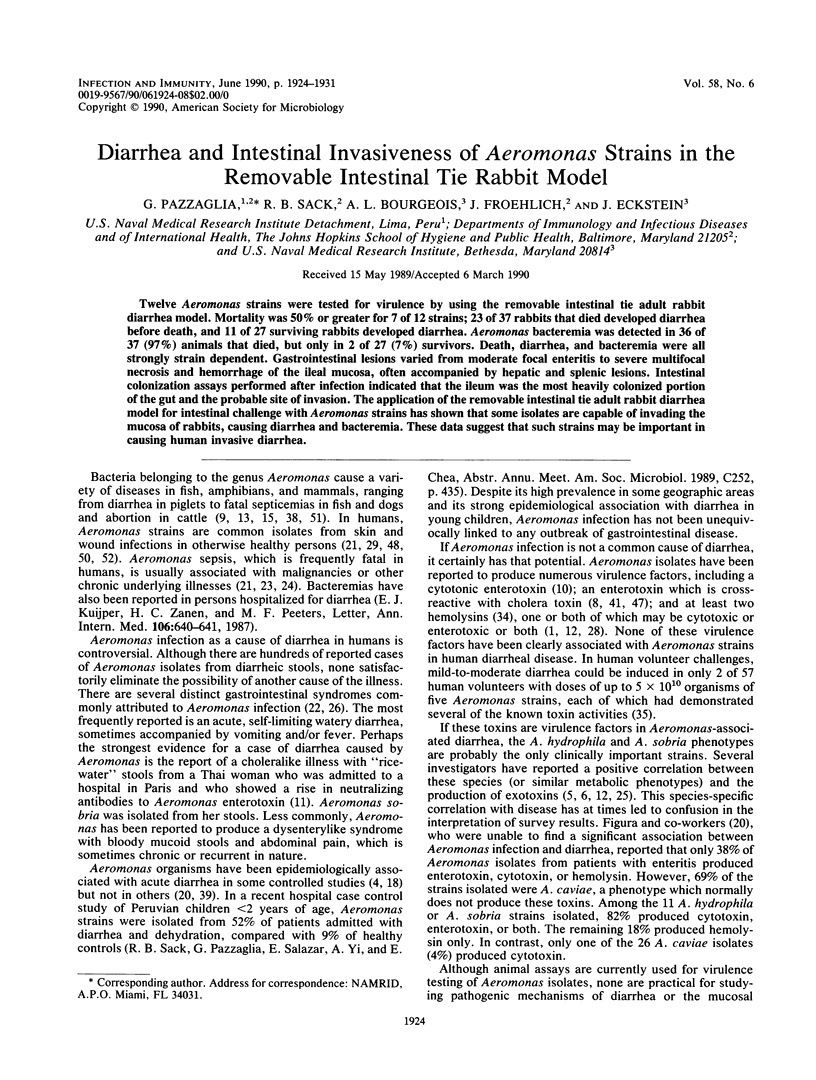
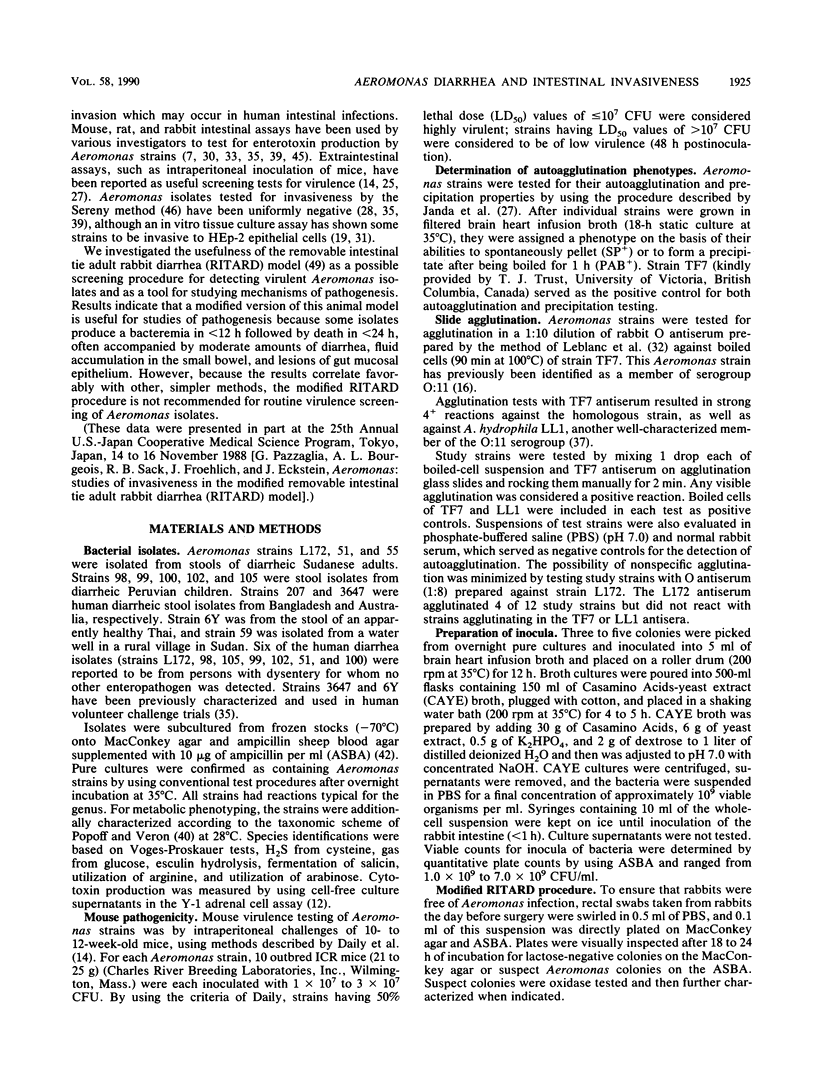
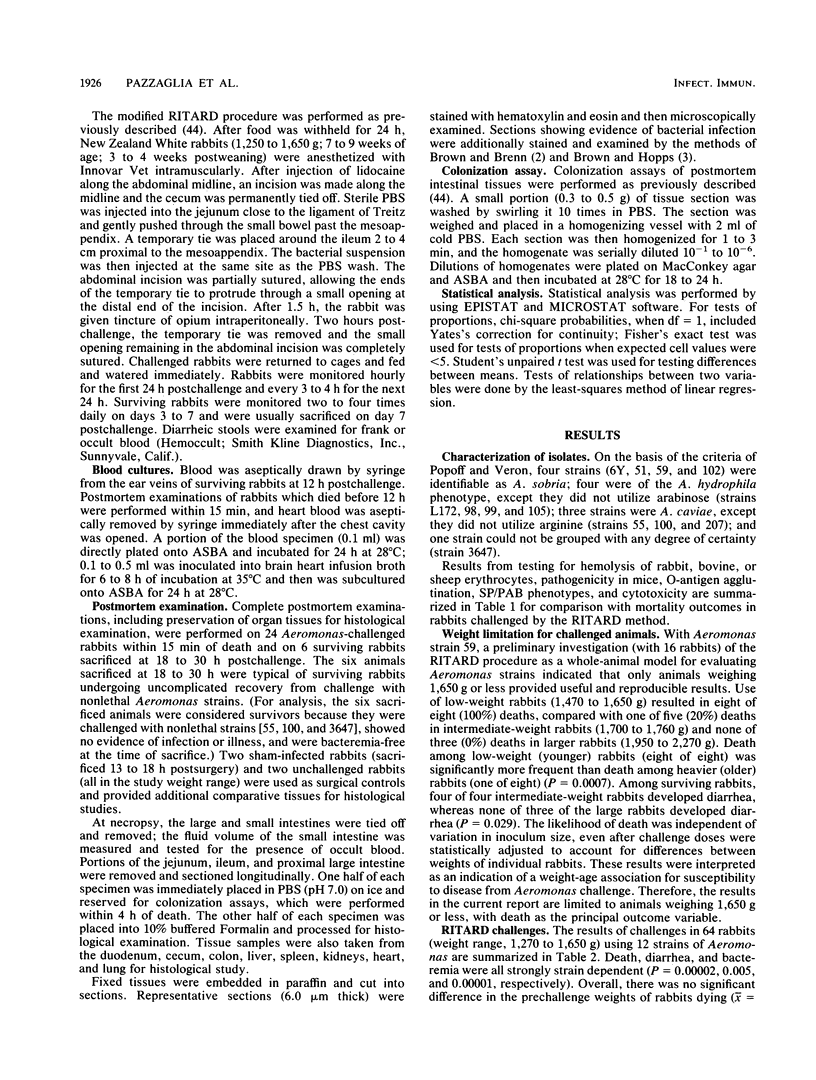

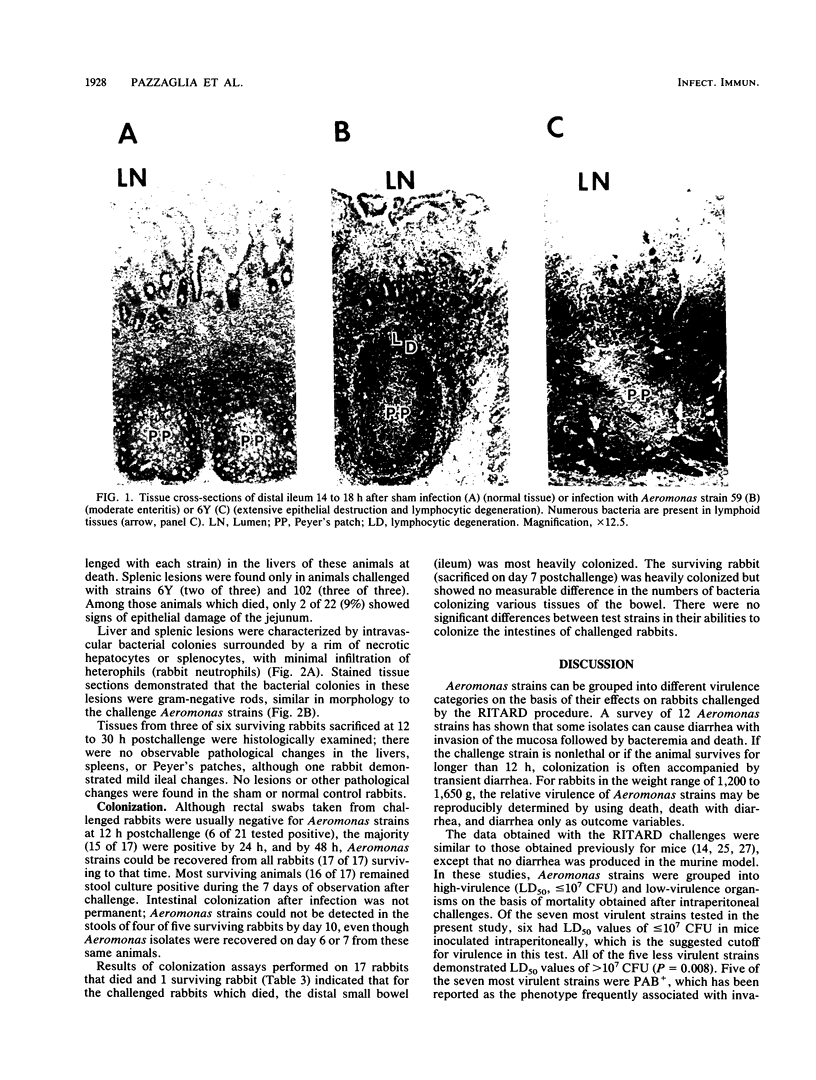
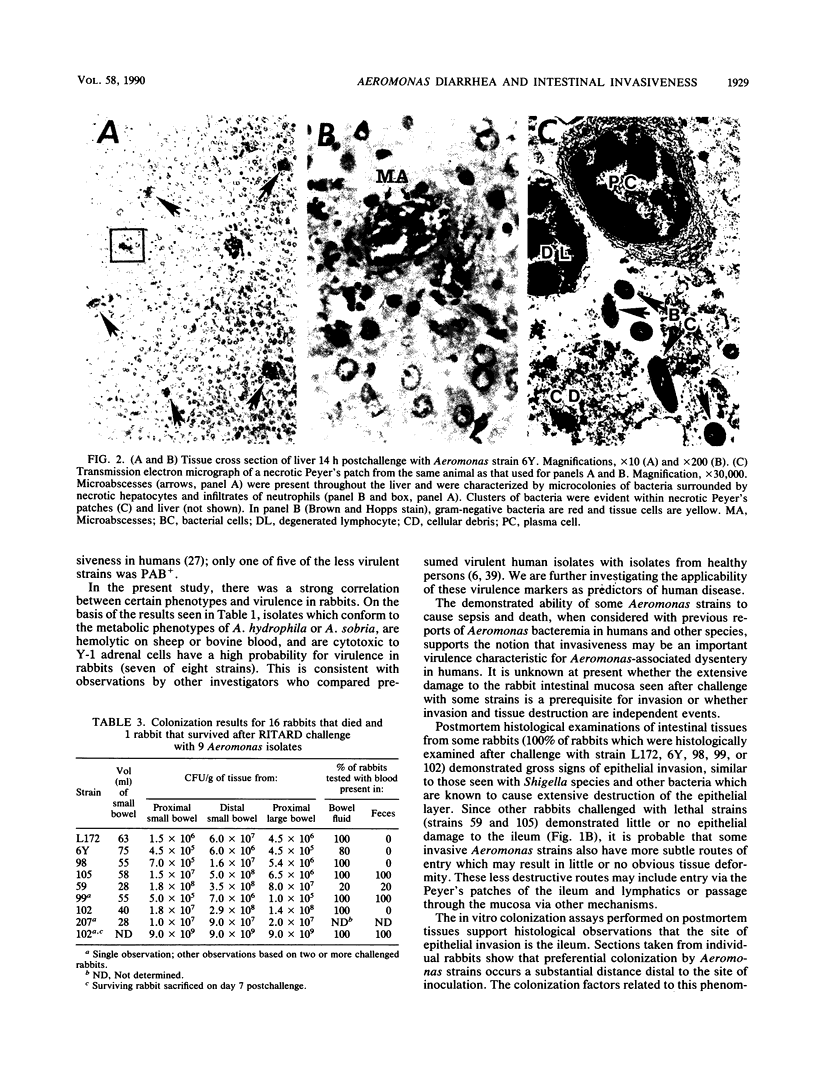
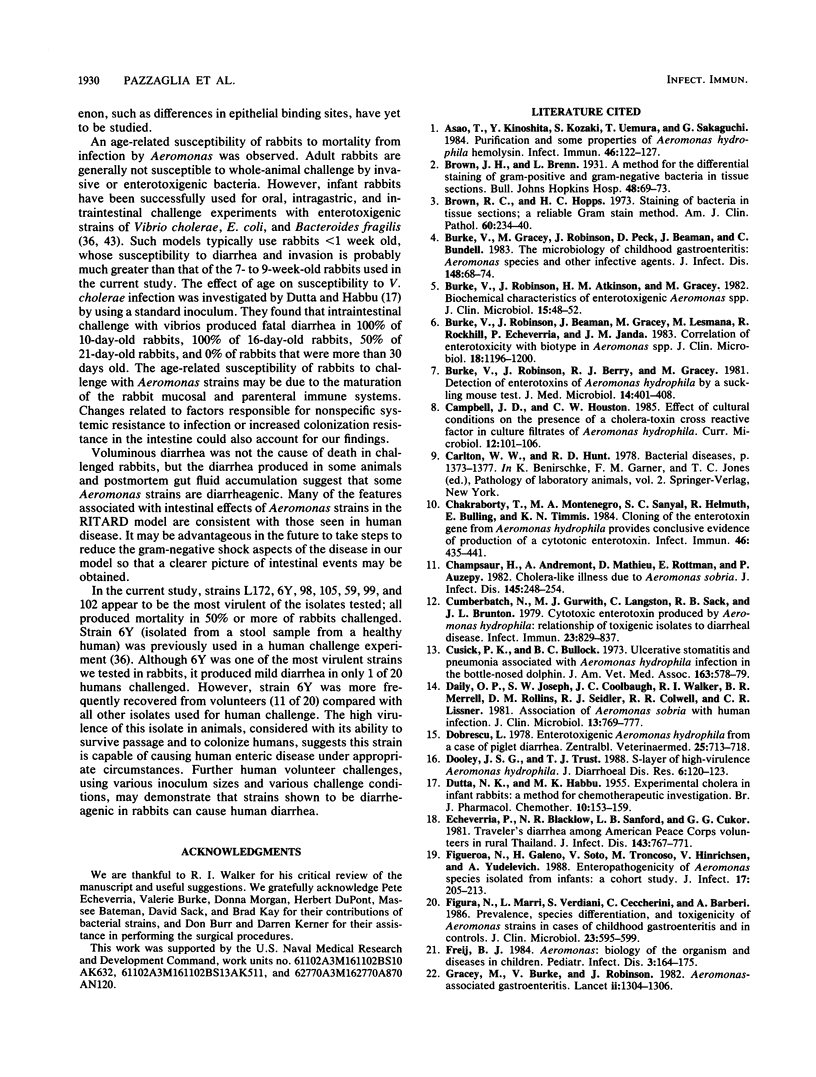
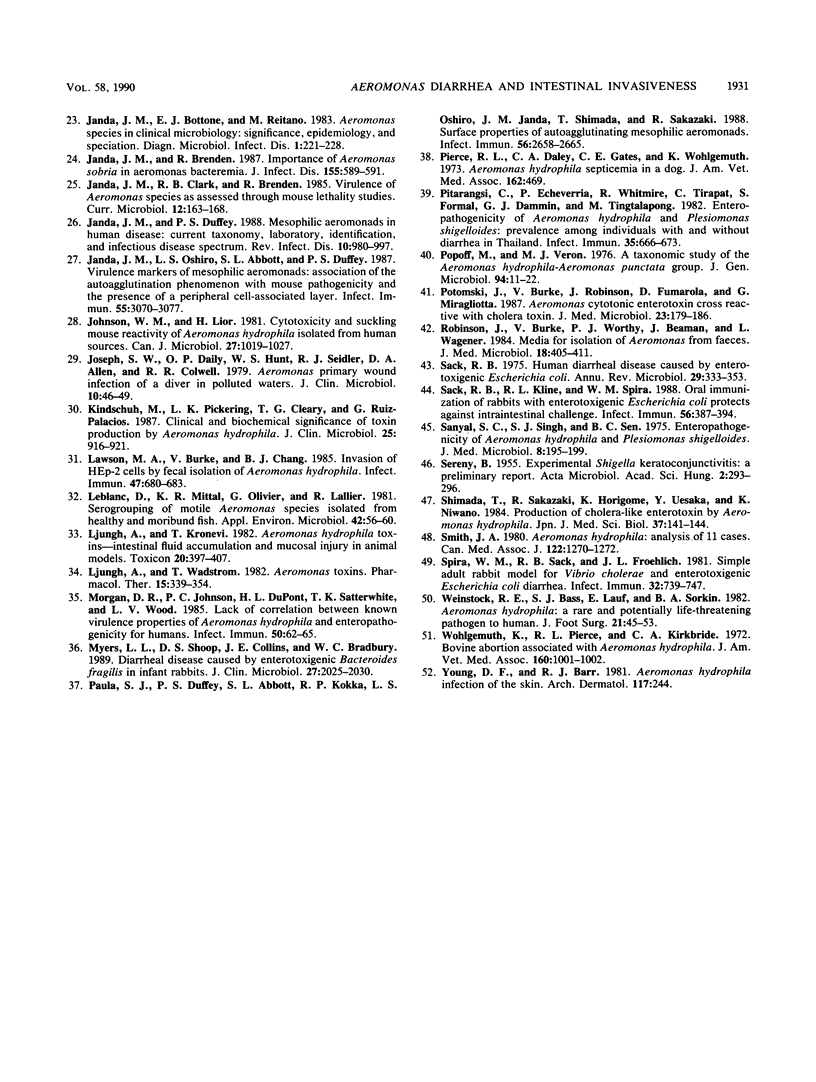
Images in this article
Selected References
These references are in PubMed. This may not be the complete list of references from this article.
- Asao T., Kinoshita Y., Kozaki S., Uemura T., Sakaguchi G. Purification and some properties of Aeromonas hydrophila hemolysin. Infect Immun. 1984 Oct;46(1):122–127. doi: 10.1128/iai.46.1.122-127.1984. [DOI] [PMC free article] [PubMed] [Google Scholar]
- Brown R. C., Hopps H. C. Staining of bacteria in tissue sections: a reliable gram stain method. Am J Clin Pathol. 1973 Aug;60(2):234–240. doi: 10.1093/ajcp/60.2.234. [DOI] [PubMed] [Google Scholar]
- Burke V., Gracey M., Robinson J., Peck D., Beaman J., Bundell C. The microbiology of childhood gastroenteritis: Aeromonas species and other infective agents. J Infect Dis. 1983 Jul;148(1):68–74. doi: 10.1093/infdis/148.1.68. [DOI] [PubMed] [Google Scholar]
- Burke V., Robinson J., Atkinson H. M., Gracey M. Biochemical characteristics of enterotoxigenic Aeromonas spp. J Clin Microbiol. 1982 Jan;15(1):48–52. doi: 10.1128/jcm.15.1.48-52.1982. [DOI] [PMC free article] [PubMed] [Google Scholar]
- Burke V., Robinson J., Beaman J., Gracey M., Lesmana M., Rockhill R., Echeverria P., Janda J. M. Correlation of enterotoxicity with biotype in Aeromonas spp. J Clin Microbiol. 1983 Nov;18(5):1196–1200. doi: 10.1128/jcm.18.5.1196-1200.1983. [DOI] [PMC free article] [PubMed] [Google Scholar]
- Burke V., Robinson J., Berry R. J., Gracey M. Detection of enterotoxins of Aeromonas hydrophila by a suckling-mouse test. J Med Microbiol. 1981 Nov;14(4):401–408. doi: 10.1099/00222615-14-4-401. [DOI] [PubMed] [Google Scholar]
- Chakraborty T., Montenegro M. A., Sanyal S. C., Helmuth R., Bulling E., Timmis K. N. Cloning of enterotoxin gene from Aeromonas hydrophila provides conclusive evidence of production of a cytotonic enterotoxin. Infect Immun. 1984 Nov;46(2):435–441. doi: 10.1128/iai.46.2.435-441.1984. [DOI] [PMC free article] [PubMed] [Google Scholar]
- Champsaur H., Adremont A., Mathieu D., Rottman E., Auzepy P. Cholera-like illness due to Aeromonas sobria. J Infect Dis. 1982 Feb;145(2):248–254. doi: 10.1093/infdis/145.2.248. [DOI] [PubMed] [Google Scholar]
- Cumberbatch N., Gurwith M. J., Langston C., Sack R. B., Brunton J. L. Cytotoxic enterotoxin produced by Aeromonas hydrophila: relationship of toxigenic isolates to diarrheal disease. Infect Immun. 1979 Mar;23(3):829–837. doi: 10.1128/iai.23.3.829-837.1979. [DOI] [PMC free article] [PubMed] [Google Scholar]
- Cusick P. K., Bullock B. C. Ulcerative dermatitis and pneumonia associated with Aeromonas hydrophila infection in the bottle-nosed dolphin. J Am Vet Med Assoc. 1973 Sep 15;163(6):578–579. [PubMed] [Google Scholar]
- DUTTA N. K., HABBU M. K. Experimental cholera in infant rabbits: a method for chemotherapeutic investigation. Br J Pharmacol Chemother. 1955 Jun;10(2):153–159. doi: 10.1111/j.1476-5381.1955.tb00074.x. [DOI] [PMC free article] [PubMed] [Google Scholar]
- Daily O. P., Joseph S. W., Coolbaugh J. C., Walker R. I., Merrell B. R., Rollins D. M., Seidler R. J., Colwell R. R., Lissner C. R. Association of Aeromonas sobria with human infection. J Clin Microbiol. 1981 Apr;13(4):769–777. doi: 10.1128/jcm.13.4.769-777.1981. [DOI] [PMC free article] [PubMed] [Google Scholar]
- Dobrescu L. Enterotoxigenic Aeromonas hydrophila from a case of piglet diarrhoea. Zentralbl Veterinarmed B. 1978 Nov;25(9):713–718. doi: 10.1111/j.1439-0450.1978.tb01066.x. [DOI] [PubMed] [Google Scholar]
- Dooley J. S., Trust T. J. S-layer of high-virulence Aeromonas hydrophila. J Diarrhoeal Dis Res. 1988 Jun;6(2):120–123. [PubMed] [Google Scholar]
- Echeverria P., Blacklow N. R., Sanford L. B., Cukor G. G. Travelers' diarrhea among American Peace Corps volunteers in rural Thailand. J Infect Dis. 1981 Jun;143(6):767–771. doi: 10.1093/infdis/143.6.767. [DOI] [PubMed] [Google Scholar]
- Figueroa G., Galeno H., Soto V., Troncoso M., Hinrichsen V., Yudelevich A. Enteropathogenicity of Aeromonas species isolated from infants: a cohort study. J Infect. 1988 Nov;17(3):205–213. doi: 10.1016/s0163-4453(88)96450-x. [DOI] [PubMed] [Google Scholar]
- Figura N., Marri L., Verdiani S., Ceccherini C., Barberi A. Prevalence, species differentiation, and toxigenicity of Aeromonas strains in cases of childhood gastroenteritis and in controls. J Clin Microbiol. 1986 Mar;23(3):595–599. doi: 10.1128/jcm.23.3.595-599.1986. [DOI] [PMC free article] [PubMed] [Google Scholar]
- Freij B. J. Aeromonas: biology of the organism and diseases in children. Pediatr Infect Dis. 1984 Mar-Apr;3(2):164–175. [PubMed] [Google Scholar]
- Gracey M., Burke V., Robinson J. Aeromonas-associated gastroenteritis. Lancet. 1982 Dec 11;2(8311):1304–1306. doi: 10.1016/s0140-6736(82)91510-0. [DOI] [PubMed] [Google Scholar]
- Janda J. M., Bottone E. J., Reitano M. Aeromonas species in clinical microbiology: significance, epidemiology, and speciation. Diagn Microbiol Infect Dis. 1983 Sep;1(3):221–228. doi: 10.1016/0732-8893(83)90021-4. [DOI] [PubMed] [Google Scholar]
- Janda J. M., Brenden R. Importance of Aeromonas sobria in Aeromonas bacteremia. J Infect Dis. 1987 Mar;155(3):589–591. doi: 10.1093/infdis/155.3.589. [DOI] [PubMed] [Google Scholar]
- Janda J. M., Duffey P. S. Mesophilic aeromonads in human disease: current taxonomy, laboratory identification, and infectious disease spectrum. Rev Infect Dis. 1988 Sep-Oct;10(5):980–997. doi: 10.1093/clinids/10.5.980. [DOI] [PubMed] [Google Scholar]
- Janda J. M., Oshiro L. S., Abbott S. L., Duffey P. S. Virulence markers of mesophilic aeromonads: association of the autoagglutination phenomenon with mouse pathogenicity and the presence of a peripheral cell-associated layer. Infect Immun. 1987 Dec;55(12):3070–3077. doi: 10.1128/iai.55.12.3070-3077.1987. [DOI] [PMC free article] [PubMed] [Google Scholar]
- Johnson W. M., Lior H. Cytotoxicity and suckling mouse reactivity of Aeromonas hydrophila isolated from human sources. Can J Microbiol. 1981 Oct;27(10):1019–1027. doi: 10.1139/m81-159. [DOI] [PubMed] [Google Scholar]
- Joseph S. W., Daily O. P., Hunt W. S., Seidler R. J., Allen D. A., Colwell R. R. Aeromonas primary wound infection of a diver in polluted waters. J Clin Microbiol. 1979 Jul;10(1):46–49. doi: 10.1128/jcm.10.1.46-49.1979. [DOI] [PMC free article] [PubMed] [Google Scholar]
- Kindschuh M., Pickering L. K., Cleary T. G., Ruiz-Palacios G. Clinical and biochemical significance of toxin production by Aeromonas hydrophila. J Clin Microbiol. 1987 May;25(5):916–921. doi: 10.1128/jcm.25.5.916-921.1987. [DOI] [PMC free article] [PubMed] [Google Scholar]
- Lawson M. A., Burke V., Chang B. J. Invasion of HEp-2 cells by fecal isolates of Aeromonas hydrophila. Infect Immun. 1985 Mar;47(3):680–683. doi: 10.1128/iai.47.3.680-683.1985. [DOI] [PMC free article] [PubMed] [Google Scholar]
- Leblanc D., Mittal K. R., Olivier G., Lallier R. Serogrouping of motile Aeromonas species isolated from healthy and moribund fish. Appl Environ Microbiol. 1981 Jul;42(1):56–60. doi: 10.1128/aem.42.1.56-60.1981. [DOI] [PMC free article] [PubMed] [Google Scholar]
- Ljungh A., Kronevi T. Aeromonas hydrophila toxins - intestinal fluid accumulation and mucosal injury in animal models. Toxicon. 1982;20(2):397–407. doi: 10.1016/0041-0101(82)90002-2. [DOI] [PubMed] [Google Scholar]
- Ljungh A., Wadström T. Aeromonas toxins. Pharmacol Ther. 1981;15(3):339–354. doi: 10.1016/0163-7258(81)90049-8. [DOI] [PubMed] [Google Scholar]
- Morgan D. R., Johnson P. C., DuPont H. L., Satterwhite T. K., Wood L. V. Lack of correlation between known virulence properties of Aeromonas hydrophila and enteropathogenicity for humans. Infect Immun. 1985 Oct;50(1):62–65. doi: 10.1128/iai.50.1.62-65.1985. [DOI] [PMC free article] [PubMed] [Google Scholar]
- Myers L. L., Shoop D. S., Collins J. E., Bradbury W. C. Diarrheal disease caused by enterotoxigenic Bacteroides fragilis in infant rabbits. J Clin Microbiol. 1989 Sep;27(9):2025–2030. doi: 10.1128/jcm.27.9.2025-2030.1989. [DOI] [PMC free article] [PubMed] [Google Scholar]
- Paula S. J., Duffey P. S., Abbott S. L., Kokka R. P., Oshiro L. S., Janda J. M., Shimada T., Sakazaki R. Surface properties of autoagglutinating mesophilic aeromonads. Infect Immun. 1988 Oct;56(10):2658–2665. doi: 10.1128/iai.56.10.2658-2665.1988. [DOI] [PMC free article] [PubMed] [Google Scholar]
- Pierce R. L., Daley C. A., Gates C. E., Wohlgemuth K. Aeromonas hydrophila septicemia in a dog. J Am Vet Med Assoc. 1973 Mar 15;162(6):469–469. [PubMed] [Google Scholar]
- Pitarangsi C., Echeverria P., Whitmire R., Tirapat C., Formal S., Dammin G. J., Tingtalapong M. Enteropathogenicity of Aeromonas hydrophila and Plesiomonas shigelloides: prevalence among individuals with and without diarrhea in Thailand. Infect Immun. 1982 Feb;35(2):666–673. doi: 10.1128/iai.35.2.666-673.1982. [DOI] [PMC free article] [PubMed] [Google Scholar]
- Popoff M., Véron M. A taxonomic study of the Aeromonas hydrophila-Aeromonas punctata group. J Gen Microbiol. 1976 May;94(1):11–22. doi: 10.1099/00221287-94-1-11. [DOI] [PubMed] [Google Scholar]
- Potomski J., Burke V., Robinson J., Fumarola D., Miragliotta G. Aeromonas cytotonic enterotoxin cross reactive with cholera toxin. J Med Microbiol. 1987 Mar;23(2):179–186. doi: 10.1099/00222615-23-2-179. [DOI] [PubMed] [Google Scholar]
- Robinson J., Burke V., Worthy P. J., Beaman J., Wagener L. Media for isolation of Aeromonas spp. from faeces. J Med Microbiol. 1984 Dec;18(3):405–411. doi: 10.1099/00222615-18-3-405. [DOI] [PubMed] [Google Scholar]
- SERENY B. Experimental shigella keratoconjunctivitis; a preliminary report. Acta Microbiol Acad Sci Hung. 1955;2(3):293–296. [PubMed] [Google Scholar]
- Sack R. B. Human diarrheal disease caused by enterotoxigenic Escherichia coli. Annu Rev Microbiol. 1975;29:333–353. doi: 10.1146/annurev.mi.29.100175.002001. [DOI] [PubMed] [Google Scholar]
- Sack R. B., Kline R. L., Spira W. M. Oral immunization of rabbits with enterotoxigenic Escherichia coli protects against intraintestinal challenge. Infect Immun. 1988 Feb;56(2):387–394. doi: 10.1128/iai.56.2.387-394.1988. [DOI] [PMC free article] [PubMed] [Google Scholar]
- Sanyal S. C., Singh S. J., Sen P. C. Enteropathogenicity of Aeromonas hydrophila and Plesiomonas shigelloides. J Med Microbiol. 1975 Feb;8(1):195–198. doi: 10.1099/00222615-8-1-195. [DOI] [PubMed] [Google Scholar]
- Shimada T., Sakazaki R., Horigome K., Uesaka Y., Niwano K. Production of cholera-like enterotoxin by Aeromonas hydrophila. Jpn J Med Sci Biol. 1984 Jun;37(3):141–144. doi: 10.7883/yoken1952.37.141. [DOI] [PubMed] [Google Scholar]
- Smith J. A. Aeromonas hydrophila: analysis of 11 cases. Can Med Assoc J. 1980 Jun 7;122(11):1270–1272. [PMC free article] [PubMed] [Google Scholar]
- Spira W. M., Sack R. B., Froehlich J. L. Simple adult rabbit model for Vibrio cholerae and enterotoxigenic Escherichia coli diarrhea. Infect Immun. 1981 May;32(2):739–747. doi: 10.1128/iai.32.2.739-747.1981. [DOI] [PMC free article] [PubMed] [Google Scholar]
- Weinstock R. E., Bass S. J., Lauf E., Sorkin B. A. Aeromonas hydrophilia: a rare and potentially life-threatening pathogen to humans. J Foot Surg. 1982 Spring;21(1):45–53. [PubMed] [Google Scholar]
- Wohlgemuth K., Pierce R. L., Kirkbride C. A. Bovine abortion associated with Aeromonas hydrophila. J Am Vet Med Assoc. 1972 Apr 1;160(7):1001–1002. [PubMed] [Google Scholar]
- Young D. F., Barr R. J. Aeromonas hydrophila infection of the skin. Arch Dermatol. 1981 Apr;117(4):244–244. [PubMed] [Google Scholar]




